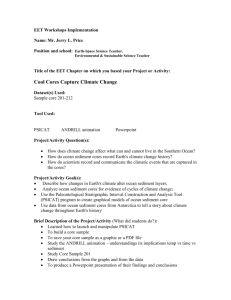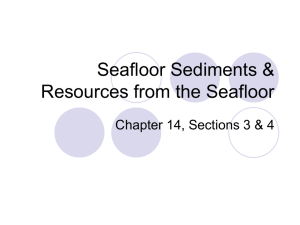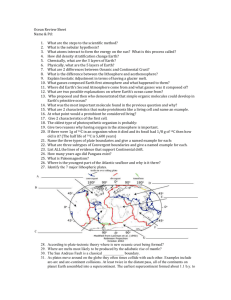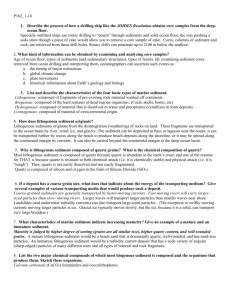Sediments Reading
advertisement
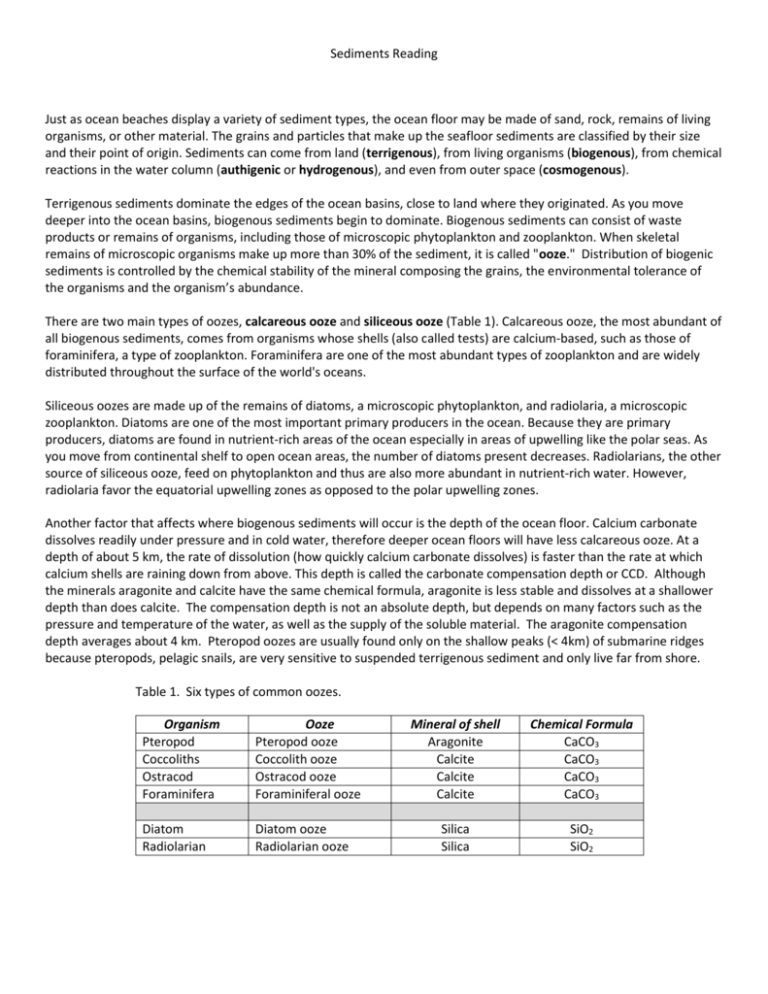
Sediments Reading Just as ocean beaches display a variety of sediment types, the ocean floor may be made of sand, rock, remains of living organisms, or other material. The grains and particles that make up the seafloor sediments are classified by their size and their point of origin. Sediments can come from land (terrigenous), from living organisms (biogenous), from chemical reactions in the water column (authigenic or hydrogenous), and even from outer space (cosmogenous). Terrigenous sediments dominate the edges of the ocean basins, close to land where they originated. As you move deeper into the ocean basins, biogenous sediments begin to dominate. Biogenous sediments can consist of waste products or remains of organisms, including those of microscopic phytoplankton and zooplankton. When skeletal remains of microscopic organisms make up more than 30% of the sediment, it is called "ooze." Distribution of biogenic sediments is controlled by the chemical stability of the mineral composing the grains, the environmental tolerance of the organisms and the organism’s abundance. There are two main types of oozes, calcareous ooze and siliceous ooze (Table 1). Calcareous ooze, the most abundant of all biogenous sediments, comes from organisms whose shells (also called tests) are calcium-based, such as those of foraminifera, a type of zooplankton. Foraminifera are one of the most abundant types of zooplankton and are widely distributed throughout the surface of the world's oceans. Siliceous oozes are made up of the remains of diatoms, a microscopic phytoplankton, and radiolaria, a microscopic zooplankton. Diatoms are one of the most important primary producers in the ocean. Because they are primary producers, diatoms are found in nutrient-rich areas of the ocean especially in areas of upwelling like the polar seas. As you move from continental shelf to open ocean areas, the number of diatoms present decreases. Radiolarians, the other source of siliceous ooze, feed on phytoplankton and thus are also more abundant in nutrient-rich water. However, radiolaria favor the equatorial upwelling zones as opposed to the polar upwelling zones. Another factor that affects where biogenous sediments will occur is the depth of the ocean floor. Calcium carbonate dissolves readily under pressure and in cold water, therefore deeper ocean floors will have less calcareous ooze. At a depth of about 5 km, the rate of dissolution (how quickly calcium carbonate dissolves) is faster than the rate at which calcium shells are raining down from above. This depth is called the carbonate compensation depth or CCD. Although the minerals aragonite and calcite have the same chemical formula, aragonite is less stable and dissolves at a shallower depth than does calcite. The compensation depth is not an absolute depth, but depends on many factors such as the pressure and temperature of the water, as well as the supply of the soluble material. The aragonite compensation depth averages about 4 km. Pteropod oozes are usually found only on the shallow peaks (< 4km) of submarine ridges because pteropods, pelagic snails, are very sensitive to suspended terrigenous sediment and only live far from shore. Table 1. Six types of common oozes. Organism Pteropod Coccoliths Ostracod Foraminifera Ooze Pteropod ooze Coccolith ooze Ostracod ooze Foraminiferal ooze Diatom Radiolarian Diatom ooze Radiolarian ooze Mineral of shell Aragonite Calcite Calcite Calcite Chemical Formula CaCO3 CaCO3 CaCO3 CaCO3 Silica Silica SiO2 SiO2 Sea Floor Sediment Thickness As soon as sea floor forms at the oceanic ridge crest, sediment begins to accumulate upon it. Rate of accumulation can vary depending upon a number of factors such as: 1. Rate of organic productivity in the overlying waters. 2. Amount of wind-transported sediment from the land or fine particles from volcanic eruptions which settle from out of the atmosphere. 3. Rate at which cosmic dust falls to the Earth. 4. Speed at which authigenic sediments form. 5. Quantity of water-transported sediments that sink to the sea floor. 6. Rate of sediment dissolution or erosion. 7. Amount of ice-rafted sediments released as icebergs melt. In general, the farther a section of sea floor is from the oceanic ridge crest, the older the sea floor, the longer the sediments have had to collect and the thicker the accumulation of sediment. Therefore the three interrelated variables determining the amount of sediment found on the sea floor are the rate at which sediments collect, the age of the sea floor and the distance the section of sea floor is from the oceanic crest. Given any two of these variables, it is possible to determine the third. Example 1. If the average rate of ocean basin expansion is 3 cm/yr and a studied section of sea floor is 400 km from the crest, how thick should the sediments be if the average rate of accumulation is 2 cm/1000 yrs.? A. First determine the average sea floor spreading rate Average ocean basin expansion rate = 3 cm/yr Average sea floor spreading rate = 3 cm/yr x ½ = 1.5 cm/yr B. Determine the age of the sea floor upon which the sediment has collected. This can be accomplished by calculating how long it has taken this section of sea floor to be moved 400 km from the ridge crest. Convert 400 km into centimeters. 400 km x 1000 m/km x 100 cm/m = 4 x 107 cm To determine the time required for the sea floor to spread 4x107 cm at the rate of 1.5 cm/yr, divide the distance by the rate of spreading. 4x107 cm ÷ 1.5 cm/yr = 2.6x107 yrs C. Sediment has been accumulating at the average rate of 2 cm/1000 yrs. To calculate the expected thickness of the sediment, multiply the time interval by the rate of accumulation. 2.6x107 yrs x 2 cm/103 yrs = 0.8666 x104 cm = 8666 cm D. Convert the thickness into meters. 8666 cm x 1m/100 cm = 86.66 m Example 2. Sediment has been collecting at the average rate of 3 cm/1000 years. A section of sea floor is covered by 60m of sediment and is 200 km from the crest of the ridge. What was the average rate of sea floor spreading for this section of sea floor? A. Determine the time interval required to collect 60m if sediment was deposited at the average rate of 3 cm/1000 yrs. Convert the 60m of sediment into centimeters of sediment. 60 m x 100 cm/m = 6000 cm To determine the time required to deposit 6000 cm, divide the sediment thickness by the rate of accumulation. 6000 cm ÷ 3 cm/1000 yrs = 2x106 yrs If it has taken 2x106 yrs for the sediment to have accumulated, the sea floor must be at least 2x106 yrs old and it has required 2x106 yrs for the sea floor to have spread 200 km from the ridge crest. B. To determine the average rate of sea floor spreading convert the distance traveled into centimeters and then divide the distance by the time required to travel that distance. 200 km x 1000 m/km x 100 cm/m = 200x105cm 200x105cm/20x105yrs = 10 cm/yr Example 3. A section of sea floor is covered by 600 m of sediment and is located 300 km from the ridge crest. Average sea floor spreading rate is 5 cm/yr. What is the average rate per 1000 years at which sediment is accumulating on the sea floor? A. To determine the age of the sea floor, calculate the time required for the sea floor to spread 300 km from the crest at 5 cm/yr. Convert the distance to centimeters and divide by the average spreading rate. 300 km x 1000 m/km x 100 cm/m = 3x107 cm 3x107 cm ÷ 5 cm/yr = 30x106 cm x 1yr/5 cm = 60x106 yrs It has taken 60x106 yrs to collect 600 m of sediment. B. To determine the average annual rate of sediment accumulation, convert the sediment thickness to centimeters and divide the amount of sediment by the time it took for the sediment to accumulate. 600 m x 100 cm/m = 6x104 cm 6x104 cm ÷ 60x106 yrs = 0.001 cm/yr Convert to the average accumulation per 1000 years by multiplying the average annual rate of sedimentation by 1000. 1000 x 0.001 cm/yr = 1 cm per 1000 years

